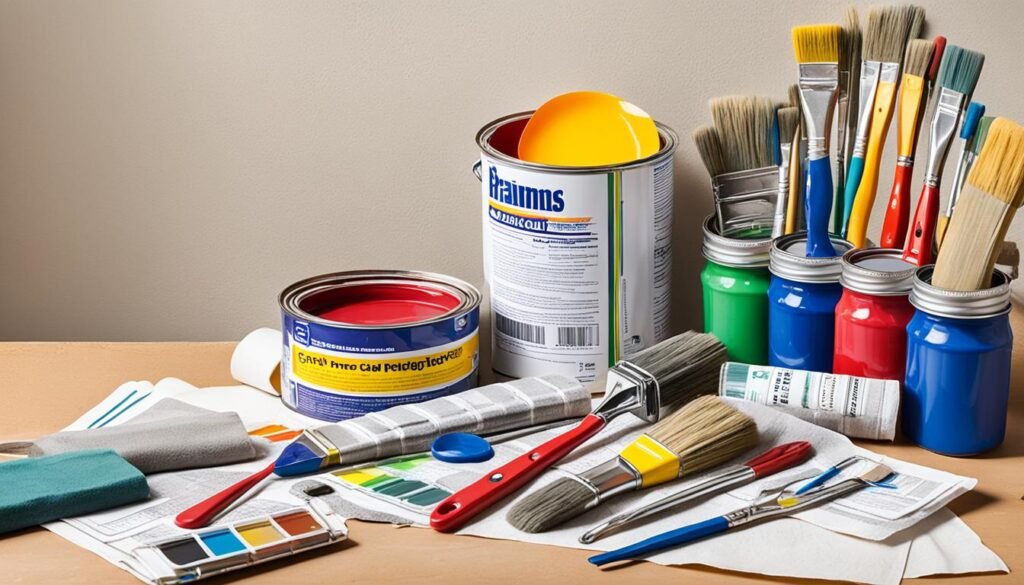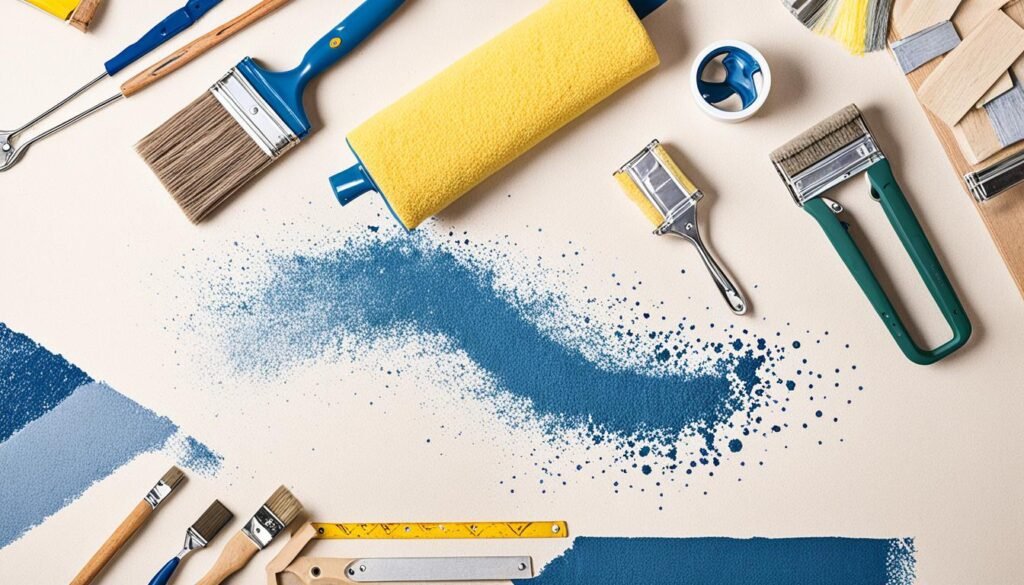Whether you’re a seasoned DIY painter or just starting out, having the essential tools for painting is crucial for achieving professional-quality results. From brushes and rollers to tape and drop cloths, each tool plays a significant role in creating a flawless finish. So, before you dive into your next painting project, let’s take a closer look at the top 10 tools every DIY painter needs.
Key Takeaways:
- Having the right tools is essential for achieving professional-quality results in DIY painting projects.
- Each painting tool, from brushes to rollers, plays a significant role in creating a flawless finish.
- Investing in high-quality tools can make a noticeable difference in the outcome of your DIY painting projects.
- Knowing which tools to use and how to use them correctly is key to a successful painting project.
- By having the essential tools on hand, you can tackle any painting project with confidence and achieve professional-looking results.
Essential Painting Supplies for DIYers
In addition to the essential tools mentioned above, there are a few other painting supplies that every DIYer should have on hand:
- Drop Cloths: Protect your floors and furniture from paint splatters with durable and waterproof drop cloths. These can be easily spread out and positioned to cover large areas.
- Painter’s Tape: Achieve clean and precise lines by using painter’s tape to mask off areas that you don’t want to paint. This will help you create sharp edges and prevent paint bleed.
- Primer: Applying a coat of primer before painting can help improve adhesion and create a smooth surface for the paint. Choose a primer that is suitable for the surface you are painting.
- Paint Trays: Pour your paint into a paint tray to make it easier to load your roller or brush. Look for trays with deep wells to hold a sufficient amount of paint.
- Paint Brushes: Invest in a variety of high-quality paint brushes in different sizes for different painting tasks. Synthetic bristle brushes are great for water-based paints, while natural bristle brushes are ideal for oil-based paints.
- Roller Covers: Choose roller covers with the appropriate nap length for the surface you are painting. Short nap covers are suitable for smooth surfaces, while long nap covers are better for textured surfaces.
- Extension Poles: Extend your reach with extension poles that can be attached to paint rollers and brushes. This will allow you to easily paint high walls and ceilings without the need for a ladder.
- Sandpaper: Prepare surfaces for painting by sanding them with sandpaper. This will help smooth out imperfections and create a better surface for paint adhesion.
- Paint Can Opener: Avoid damaging your paint cans by using a paint can opener to remove the lids. These handy tools make it easier to open cans without bending or denting them.
- Cleaning Supplies: After you finish painting, make sure to clean your brushes, rollers, and other painting equipment properly. Use soap and water for water-based paints and mineral spirits for oil-based paints.
Having these additional painting supplies will ensure that you have everything you need to tackle your DIY painting projects with ease and achieve professional-looking results.

Tips for Using Painter's Tape:
When using painter’s tape, make sure to apply it firmly and evenly to the surface. Press down on the edges to create a tight seal and prevent paint from seeping underneath the tape. Remove the tape while the paint is still slightly wet for clean and sharp lines.
| Paint Supply | Description |
|---|---|
| Drop Cloths | Protects floors and furniture from paint splatters |
| Painter’s Tape | Masks off areas for clean and precise lines |
| Primer | Creates a smooth surface for paint adhesion |
| Paint Trays | Holds paint for easy loading of roller or brush |
| Paint Brushes | Applies paint evenly to various surfaces |
| Roller Covers | Selects the appropriate nap length for the surface |
| Extension Poles | Extends reach for painting high walls and ceilings |
| Sandpaper | Prepares surfaces by smoothing out imperfections |
| Paint Can Opener | Opens paint cans without damaging them |
| Cleaning Supplies | Cleans brushes, rollers, and other painting equipment |
Tips for a Successful DIY Painting Project
Embarking on a DIY painting project can be a fulfilling and cost-effective way to enhance your living space. Whether you’re a beginner or have some experience, these tips and tricks will help you achieve professional-looking results.
1. Prepare the Surface
Before you start painting, it’s crucial to prepare the surface properly. Clean the walls to remove any dust, dirt, or grease. Fill in any holes or cracks with spackling paste, and sand the area smooth once dry. Applying a coat of primer will ensure better adhesion and a more even finish.
2. Use High-Quality Tools and Materials
Investing in high-quality brushes, rollers, and paints can make a significant difference in the outcome of your project. Good brushes will provide better coverage and a smoother finish. Quality paint will have better color saturation and durability. Don’t forget to protect your floors and furniture with drop cloths or plastic sheets.
3. Test the Colors
Before committing to a color, it’s essential to test it on a small area of the wall. Paint swatches or small samples on different walls to see how the lighting affects the color and how it complements your furnishings. This step will help you make an informed decision and avoid any disappointments.
4. Use Proper Techniques
“Painting is like a dance. The right technique can make all the difference.” – Bob Ross
Using the proper painting techniques can make your project go smoother and produce better results. Start with the top-down approach, painting ceilings, then walls, and finally, the trim. Use long, even strokes and maintain a wet edge to avoid lap marks. If using a roller, apply paint in a “W” or “M” pattern for even coverage.
5. Take Breaks and Practice Patience
Painting can be a time-consuming process, and it’s important to pace yourself. Take short breaks to rest and stretch, especially if working on a larger project. Allow each coat to dry completely before applying the next one. Patience and attention to detail will ensure a smooth and polished finish.

6. Clean and Store Your Tools Properly
After completing your project, it’s crucial to clean your brushes, rollers, and paint trays thoroughly. Use warm, soapy water to remove any leftover paint, and allow them to dry before storing them. Proper cleaning and storage will extend the lifespan of your tools, allowing you to reuse them for future projects.
7. Have Fun and Get Creative
DIY painting projects offer the opportunity to unleash your creativity and personalize your space. Experiment with different colors, techniques, and patterns. Don’t be afraid to step out of your comfort zone and try new things. The more you practice, the more confident you’ll become in your painting abilities.
By following these painting tips and tricks, employing beginner painting techniques, and following step-by-step painting instructions, you can achieve professional-quality results. Remember, painting is a skill that improves with practice, so don’t be discouraged if your first project isn’t perfect. With time and experience, you’ll become a master DIY painter.
Conclusion
In conclusion, choosing the best paints for your DIY projects is crucial for achieving professional-quality results. Whether you’re painting furniture, walls, or decorative items, using high-quality paints can make a significant difference in the final outcome. Look for paints that offer good coverage, durability, and a smooth finish to ensure your projects stand the test of time.
When it comes to paint color ideas for DIY projects, the possibilities are endless. Experiment with bold and vibrant colors to make a statement or opt for softer hues for a more soothing effect. Consider the overall aesthetic you want to achieve and let your creativity shine through.
Remember, preparation is key before diving into any painting project. Clean and prime surfaces, sand where necessary, and use quality brushes and rollers for a seamless application. Don’t rush the process, take your time, and follow the recommended drying times between coats. With the right paints and proper techniques, you’ll be able to transform any space and bring your creative visions to life.
FAQ
What are the top 10 tools that every DIY painter needs?
The top 10 tools that every DIY painter needs are a paint roller, paintbrushes (in various sizes), painter’s tape, drop cloths, paint trays, a paint scraper, sandpaper, a putty knife, a ladder, and a paint can opener.
What are some essential painting supplies for DIYers?
In addition to the essential tools mentioned above, some other painting supplies that every DIYer should have on hand include a paint sprayer, a paint mixer, a caulk gun, a paint edger, and a paintbrush comb.
What are some tips for a successful DIY painting project?
Here are some helpful tips for a successful DIY painting project:1. Prepare the surface properly by cleaning, patching, and sanding.2. Use primer before painting to ensure better adhesion and coverage.3. Use high-quality paints to achieve a professional finish.4. Apply paint in thin, even coats and allow each coat to dry before applying the next.5. Use proper painting techniques, such as cutting in before rolling.6. Protect areas you don’t want to paint with painter’s tape and drop cloths.7. Clean your painting tools thoroughly after each use to prolong their lifespan.
What are the best paints for DIY projects?
The best paints for DIY projects depend on the specific project and surface. However, some popular options for DIY painters include latex or acrylic-based paints for walls and ceilings, enamel or oil-based paints for trim and cabinets, and chalk or milk paints for furniture and decorative projects.
What are some paint color ideas for DIY projects?
When it comes to paint color ideas for DIY projects, the options are endless. It’s important to consider the overall style and ambiance you want to create in a particular space. Some popular color ideas include neutral tones for a timeless look, bold and vibrant colors for a statement, and pastel shades for a soft and calming atmosphere.

No comment yet, add your voice below!